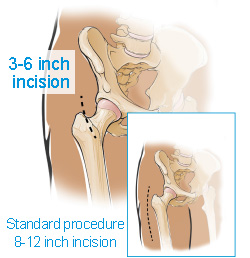The Zimmer® Anterior Supine Hip Procedure combines the benefits of Zimmer Minimally Invasive Solutions™ (MIS) procedures with the advantages of an anterior approach. In this case, the word “anterior” refers to the front of the hip. With this procedure, your surgeon utilizes a smaller incision than with traditional hip replacement surgery and has the ability to work between the leg muscles without detaching them from the thigh bones.
You may be a candidate for the Anterior Supine approach to surgery. This means you could experience the benefits associated with Zimmer Minimally Invasive Solutions (MIS) procedures and the Anterior Supine approach that are explained here. If you haven’t already, talk to your doctor to find out if this procedure is right for you because not everyone is a candidate.

Zimmer MIS Procedure
Zimmer MIS Anterior Supine Hip Procedure
Traditional surgery involves an 8-12 inch incision on the side or back of your leg. The Anterior Supine procedure uses a 3-6 inch incision on the front of your leg. This allows your surgeon to have an optimized view of your hip joint during surgery.
This procedure also allows your surgeon to preserve the tissue that keeps your joint tight, which reduces the risk of dislocation after surgery. Dislocation is when your hip comes out of the socket.
Benefits of the Zimmer MIS Anterior Supine Hip Procedure
While every patient’s experience may differ, the Anterior Supine Hip Procedure is designed to provide a number of benefits1:
- Accelerated recovery time and reduced pain, due to the minimal trauma to muscles, tendons and nerves
- Reduced scarring from the use of a smaller incision than with traditional total hip replacement
- More rapid stability of the hip, because the muscles are not disrupted during the procedure
- Possible accelerated recovery time because key muscles are not detached during the operation
In addition, because the Zimmer MIS Anterior Supine Hip Procedure is a muscle-sparing procedure, patients may experience reduced rehabilitation time following surgery, as compared with the 6-8 weeks of rehab that is typical with traditional hip replacement procedures.
